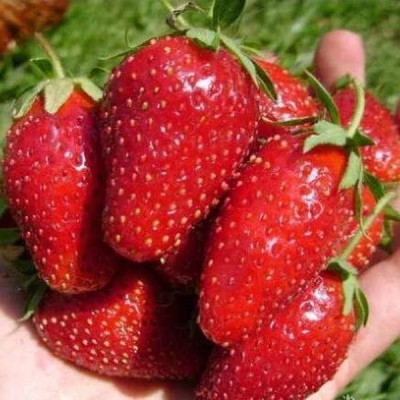
- Repairability: Yes
- Berry color: Red
- Amplitude: Yes
- Berry shape: elongated
- Scent: pronounced
- Transportability: Yes
- Possibility to grow in a greenhouse: Yes
- Care: simple
- Fruiting period: June-November
Jenny's strawberry belongs to the varieties of European selection, new to the CIS countries. It is grown in ampelous culture and in the form of bushes, and is valued for its repairability and ease of maintenance. The spread of the variety is hindered by only a limited amount of commercially available planting material.
Description of the variety
Jenny is a strawberry with bushes of compact size, small height, up to 30 cm wide. It gives very long rosette shoots up to 100 cm long. The leaves are green, without features. The bushes are very decorative, neat. Whiskers are formed before the peduncles. The buds are formed amicably, abundantly, giving the plants additional attractiveness.
Ripening terms
Fruiting begins in June and lasts until November. It passes in 2 waves, with almost no break.
Yield
High-yielding variety.
Berries and their taste
Jenny's strawberries have an elongated, fusiform shape. Red berries with a strong aroma, evenly colored. The taste is sweet, bright, slightly sourness can be observed. The average weight of a berry reaches 20-30 g.
Growing features
The variety grows well in greenhouses and outdoors, can be planted in pots on a balcony or veranda. When grown in ampelous culture, it produces berries on unrooted rosettes. In the ground, props can be used to pull the whiskers up. Jenny's drought resistance is average, it is better not to forget about watering.




Site selection and soil preparation
When planting Jenny's strawberries, you don't have to worry about choosing the right place. It tolerates insufficient lighting well, including artificial. A transplant is required every 2-3 years. The soil should be very fertile, rich in nutrients.

Pollination
The variety is self-fertile, pollination occurs without additional intervention.
Top dressing
Since the variety is distinguished by extended fruiting, it is important to maintain an adequate balance of potash fertilizers in the soil for uniform coloring of the berries. To stimulate the rapid growth of green mass in the spring, nitrogen fertilizing is used on an organic basis or ready-made, in the form of mineral mixtures. Fertilizers are applied carefully, with loosening of the root zone, after abundant watering. Liquid solutions are used strictly under the root so as not to burn the leaves.

One of the important techniques in strawberry care is feeding. Regular fertilization guarantees a rich harvest. There are several different ways to feed strawberries, and each of them is designed for a specific period of plant development. During flowering, fruiting and after it, feeding should be different.

Diseases and pests
The variety is moderately affected by fungal diseases. As a preventive measure, planting in high beds can be used to prevent the berries from coming into contact with the ground.

Strawberries are often subject to many dangerous diseases that can seriously undermine their condition. Among the most common are powdery mildew, gray mold, brown spot, anthracnose, and verticillosis. Before buying a variety, you need to inquire about its disease resistance.
Reproduction
The strawberries form a mustache profusely. The variety is propagated mainly by rosettes, easily rooting throughout the season. It feels good in a carpet fit. A new plantation is formed in autumn or late summer, choosing the strongest and strongest shoots. They are rooted, cut off from the mother plant, and transferred to a new place.

Review overview
According to gardeners, Jenny's strawberries fully justify their hopes. The variety shows abundant fruiting, the berries are beautiful, very well stored and transportable. Gardeners note the unpretentiousness of the plant, while it is thermophilic, it needs to create favorable conditions. Many people prefer to grow this variety in greenhouses or at home, avoiding excessive hypothermia of the plants.
The duration of the harvest is especially noted. But in this regard, as gardeners mention, there is a need for additional feeding, otherwise the bush will quickly deplete its strength, the berries will become smaller. But plants of this species bear fruit even on the mustache, which significantly increases the yield. Gardeners note that it is not yet possible to say how often the plantation will need to be renewed - at 2 and 3 years, the intensity of berry formation does not decrease, but the variety is new, has not been studied enough in Russian conditions.


















































































